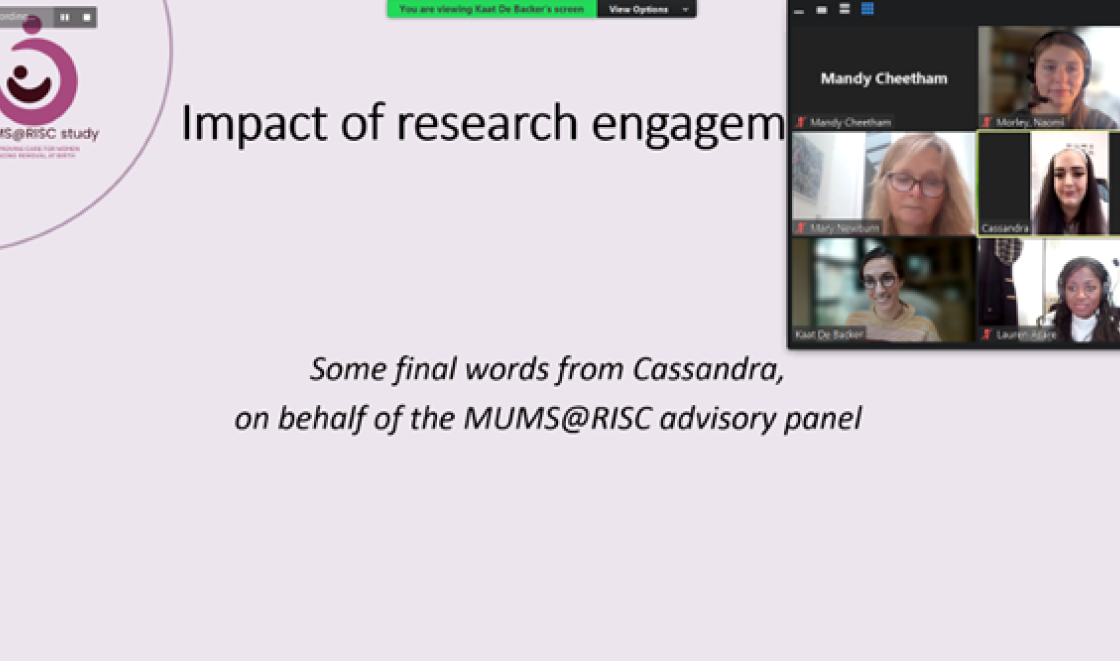Mary: I got in touch with Naomi particularly wanting to focus on how we could further service user leadership in public involvement in research. Several women involved in maternity services advocacy from a service user perspective are now working in research involvement. We want to have better infrastructure to enable people who come to research that way to be able to influence how public involvement is done, and to be confident and competent co-applicants, public involvement leaders, and mentors.
I came to Naomi directly after the Applied Research Collaboration (ARC) South London maternity and perinatal mental health annual public involvement strategy group meeting (November 2022). We had been discussing public involvement capacity building and the need for infrastructure to enable peer support, accessible involvement resources, a newsletter or other signposting mechanism, and either a new group, or to expand an existing ‘community of practice’. Rachel Plachcinski, an experienced public involvement facilitator and longstanding colleague, joined us to talk about needs.
Naomi: I am coordinating public involvement on the NIHR’s Children’s Health and Maternity national priority programme and have started a community of practice for programme partners to build partnerships and share learning in public involvement. The programme aims to work collaboratively, utilising cross-ARC expertise from all backgrounds, and building networks that create new knowledge, identify learning and future opportunities. Mary and I met through this group and when she approached me to discuss capacity building in public involvement, we felt the challenges and needs we had each encountered really resonated.
We began to plan. We were aware that there are many islands of public involvement good practice and expertise, but also wide seas of isolation and uncertainty. There are unanswered questions about ways to do public involvement well and the support that communities and individuals may need.
Naomi: Mary suggested that the national Children’s Health and Maternity programme would present a fantastic opportunity to share learning through a series of webinars with a wide audience to strengthen networks and build capacity. She was absolutely right and the collaboration was born.
Aims and objectives
We agreed to co-design and co-host three public involvement webinars as a mini-series for people with an interest in public involvement in research and services: community members and activists, experienced and early-career researchers, public involvement leads, peer researchers, third sector organisations (e.g. charities, community interest companies) and individuals. Our aims were to encourage cross-project learning and networking, and create new opportunities for developing good practice in public involvement.
We committed to:
- Test a 90-minute, lunchtime slot, enabling some people to come during their lunch break, and to avoid school drop-off and pick-up times
- Create a safe and inviting space where a wide and diverse range of contributors could address issues collaboratively
- Record the presentations and host them on YouTube so that the resources would be accessible beyond the live events
- Monitor numbers, and the public/academic/public involvement leadership roles of people attending
- Collect feedback about needs and reactions to the webinars.
The topics of the webinars were informed by the many conversations with the people in our networks. The series was designed both to be practical and to ask critical questions.
What happened in practice?
The events were advertised through email and social media with the help of the PenARC and ARC South London communications teams. Around 180 people attended the three events (in the order of 50, 70 and 60 people logged on, respectively). Each time, this was around half to threequarters of those who registered for a free place.
At each event we shared some suggested short ground rules and explained what had prompted the series. Each webinar included three presentations followed by time for discussion among all attending. Webinar topics were:
1) Building capacity in Patient and Public Involvement leadership, exploring how we can develop good practice and presenting solutions to support public partners.
2) Ethics, Equity and Budgeting in Public Involvement, focusing on how we can promote inclusive approaches that are safe whilst acknowledging people's right be heard and ensure equity of access.
3) Emotions in Public Involvement, exploring approaches to public involvement that allow knowledge to be shared through personal experiences and emotions.
Find webinar recordings here: NIHR Children’s Health and Maternity Programme - Public Involvement webinar series. A full report is in development and will be published in 2024.
Critical feedback
At each webinar, attendees were highly engaged with the topics, asking questions, giving feedback and communicating using the chat function. They had the opportunity to complete a feedback form after each event, and share their learning and reflections by email. Those who commented felt that the topics were highly relevant, and that presenters and delegates shared valuable insights and useful practical advice. People expressed gratitude that we had opened important conversations and said they had felt supported and empowered to put advice into practice. However, there was also a commonly held view that people would have liked longer breakouts sessions and more opportunity for interaction.
On reflection, as co-designers of the events, we felt the webinars were successful. This was demonstrated by the high numbers booking and attending, and the feedback. We met our aims to create a safe space to explore capacity building approaches. Positively, our hope that the webinars would enable participants to make connections, share solutions and build knowledge and confidence, seems to have been fulfilled. However, the theme of each webinar was broad, and presentations and discussion, while highly stimulating, only scratched the surface of the many important issues.
It might have been more useful to condense the focus of each event, and cover less ground to go into greater depth. For example, when hearing about being a public co-applicant, we didn’t have time to get into the detail of working collaboratively to identify the public adviser’s objectives, responsibilities, rights and needs (including financial and availability expectations); and who might mentor or support. It could be helpful to have a webinar dedicated to this topic alone, with speakers from different projects with various pitfalls encountered and good practice to share.
In effect, this was a pilot. We had agreed that depending on demand, needs expressed, and how the events were evaluated, that we would build on the mini-series by hosting or contributing to further webinars in 2024.

